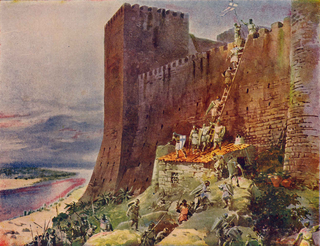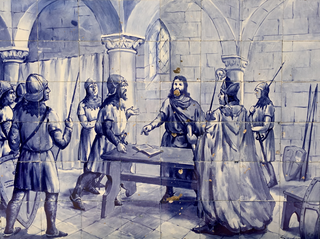 W
WThe kingdom of Portugal was established from the county of Portugal in the 1130s, ruled by the Portuguese House of Burgundy. During most of the 12th and 13th centuries, its history is chiefly that of the gradual reconquest of territory from the various Muslim principalities (taifas) of the period.
 W
WThe Battle of Valdevez took place at Arcos de Valdevez on the banks of the river Vez between the Kingdom of León and the Kingdom of Portugal in the summer of 1140 or 1141. It is one of only two pitched battles that Alfonso VII of León is known to have fought, and the only of the two not coincident with a siege. His opponent at Valdevez was his cousin Afonso I of Portugal. An armistice signed after the battle eventually became the Treaty of Zamora (1143), and ended Portugal's first war of independence. The area of the battle became known as the Veiga or Campo da Matança, the "field of killing".
 W
WThe County of Portugal refers to two successive medieval counties in the region around Braga and Porto, today corresponding to littoral northern Portugal, within which the identity of the Portuguese people formed. The first county existed from the mid-ninth to the mid-eleventh centuries as a vassalage of the Kingdom of Asturias and later the Kingdoms of Galicia and León, before being abolished as a result of rebellion. A larger entity under the same name was then reestablished in the late 11th century and subsequently elevated by its count in the mid-12th century into an independent Kingdom of Portugal.
 W
WAbūʾl-Qāsim Aḥmad ibn al-Ḥusayn ibn Qasī was a Sufi, a rebel leader against the Almoravid dynasty in Al-Garb Al-Andalus and governor of Silves for the Almohads. The main sources for his life are Ibn al-Abbār, Ibn al-Khaṭīb and ʿAbd al-Wāḥid al-Marrakūshī. The last is the source for his biography in the biographical dictionary of al-Ṣafadī.
 W
WManifestis Probatum is a papal bull dated 23 May 1179, in which Pope Alexander III officially recognised the ruler and self-proclaimed king Afonso Henriques as the first sovereign King of Portugal.
 W
WThe Battle of Ourique was a battle that took place on 25 July 1139, in which the forces of Portuguese count Afonso Henriques defeated those led by the Almoravid governor of Córdoba, Muhammad Az-Zubayr Ibn Umar, identified as "King Ismar" in Christian chronicles.
 W
WThe Conquest of Santarém took place on 15 March 1147, when the troops of the Kingdom of Portugal under the leadership of Afonso I of Portugal captured the Almoravid city of Santarém.
 W
WThe Battle of São Mamede took place on 24 June 1128 near Guimarães and is considered the seminal event for the foundation of the Kingdom of Portugal and the battle that ensured Portugal's Independence. Portuguese forces led by Afonso Henriques defeated forces led by his mother Teresa of Portugal and her lover Fernão Peres de Trava. Following São Mamede, the future king styled himself "Prince of Portugal". He would be called "King of Portugal" in 1139 and was recognised as such by neighbouring kingdoms in 1143.
 W
WThe Siege of Lisbon, from 1 July to 25 October 1147, was the military action that brought the city of Lisbon under definitive Portuguese control and expelled its Moorish overlords. The Siege of Lisbon was one of the few Christian victories of the Second Crusade—it was "the only success of the universal operation undertaken by the pilgrim army", i.e., the Second Crusade, according to the near contemporary historian Helmold, though others have questioned whether it was really part of that crusade. It is seen as a pivotal battle of the wider Reconquista.
 W
WThe Taifa of Mértola was a medieval Moorish taifa that existed in what is now southeastern Portugal. It existed during three distinct periods: from 1033 to 1044, from 1144 to 1145, and from 1146 to 1151. From 1044 until 1091 it was under the forcible control of the Taifa of Seville, by Abbad II al-Mu'tadid. Its short-lived history ended in 1151, when it was finally conquered by the Almohad Caliphate.
 W
WThe Taifa of Silves was an Arab taifa kingdom that existed in what is now southern Portugal for two distinct periods: from 1027 to 1063, and again from 1145 to 1150, when it was finally conquered by the Almohad Caliphate.
 W
WThe Treaty of Zamora recognized Portuguese independence from the Kingdom of León. Based on the terms of the accord, King Alfonso VII of León recognized the Kingdom of Portugal in the presence of his cousin King Afonso I of Portugal, witnessed by the papal representative, Cardinal Guido de Vico, at the Cathedral of Zamora. Both kings promised durable peace between their kingdoms. By this treaty Afonso I of Portugal also recognized the suzerainty of the Pope.